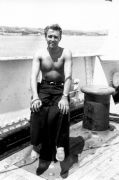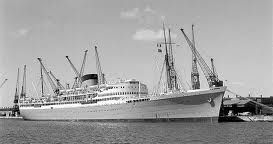BRIAN CLARE
Brian Clare b.1932 lived with his parents and siblings in Glanwern. After leaving Ardwyn Grammar School at the first opportunity, he took whatever jobs were available around Borth. For a time he drove a diesel locomotive carting away the spoil from the Dyfi embankment renovations at Ynyslas. It was bitterly cold in winter and he remembers being tossed a bundle of oily rags during his lunch break, to make a fire with. This gave the 16-year-old time to reflect on his future, and Brian, like many other local lads, viewed Borth in summer as a joy with new friends to be made, girls to chase; surrounded by an air of excitement and expectation. Unfortunately, this ended abruptly at the end of August, and generations of boys hung around the old bus shelter near Canteen Stores, to ponder the looming winter, and their immediate future.
Brian decided, at the age of 16, that it was time to go; he packed a small case, and with twenty-seven shillings in his pocket, caught the train to Liverpool. As he had relatives there, he knew that he had a place to stay. His Aunt Madge, who came to live in Borth later, proved to be invaluable as she organized a meeting for Brian with a representative from Cunard Line. This proved fruitful, as that august company agreed to sponsor him, and off he went to Sea School at Gravesend. He enjoyed his training as a steward, and left with a proficiency award.
His first job was as part of a relief crew that boarded vessels to replace crew members who had gone on leave. This shore-based activity lasted for a short time, during which Brian recalls tasting his first ever pineapple juice drink…he had never experienced it before and it tasted like heaven.
Eventually, on January 20th 1950, he went on his first voyage on the Samaria as cabin boy, his pay was £7 per month. This vessel was a large old-fashioned liner being used to carry 800 displaced persons from Germany to Halifax, Nova Scotia and Quebec. Brian shared, with twelve other crewmembers, a cabin situated directly over the propellers. Not only was it noisy, but also, by the second week out, it was quite smelly.
After three transatlantic voyages on this vessel, he joined a cargo ship The Statesman, an ex-American liberty ship. The accommodation was much better, and the voyage more exotic, visiting 17 ports in South America, the West Indies, that included a visit to Galvaston and up river to Houston, Texas. This was a memorable three-month trip, and in Barbados, like many other places in the West Indies, they still relied on paraffin lamps. Brian remembers not only the romance of it all at nightime, but also a memorable event that happened in one of the many wooden constructed bars. A huge brawl took place between his ships crew and an American one from a Lykes Line ship. “The hell with this” thought young Brian, and ducked under a corner table, where the melee looked for all the world like a scene from a western. It suddenly struck him that the wooden building and the increasingly smashed paraffin lamps, could cause a serious fire…he soon sobered up. Luckily nothing untoward happened, except that the following day most of the crewmembers sported black eyes and the like, as well as rum-induced hangovers.
Brian’s next vessel was the Petrel, a small coaster that occasionally took five days to sail from Southampton to London. Often she would proceed only after favourable weather forecasts, and it was on one of these in-between foul condition dashes across the English Channel that he was seasick for the first time.
After promotion to assistant steward, he went on the Athlone Castle, a two-class passenger liner, first and tourist, to South Africa. From there, he joined the Tudor Prince, a cargo vessel sailing from Swansea to several Mediterranean ports. Brian’s next trip on the Nicoya, a Fyffes banana boat, was quite unpleasant, as it was to West Africa where it was unbearably hot and plagued by mosquitoes, and it took quite a while to load on the 97,000 stems of banana cargo. Luckily, the next Fyffes ship, the Gahlito, went to Central America and the West Indies, an area Brian loved and visited often. Although a cargo vessel, she carried a hundred passengers.
ATHLONE CASTLE
Brian’s next vessel was the largest he had been on, and the last of his seafaring career. This vessel was the 25,600-ton liner Andes, which sailed from Southampton to ports in Brazil and Argentina. Again promoted, he was now earning the princely sum of £27 a month. This vessel had a two-deck dining room and even a balcony jutting out from the bulkhead on which a 5-piece “orchestra” played, which Brian describes as “old musoes last gig”. The fading elegance tried to recapture the great liner days of the 1920’s and 30’s. He made seven trips on this memorable vessel.
After his last trip he had spent nearly six years at sea, which he described as the happiest and most adventurous and carefree period in his life. He recalls with amusement, how one summer, at home on leave, he was inveigled by Doug Fleet the manager of the Grand Hotel Borth, to do a stint at his restaurant, where he was promoted as a Cunard Line steward, which was a great malarkey as all he really did was parade about in his uniform.
He found to his surprise that despite his sea time, that he would still have to do his national service. This proved a dilemma, as Brian was not prepared to go back down the ranks as it were. The only other option, apart from escaping the country, was to become a coalminer. As he had kept contact with many Borth summer holiday acquaintances that lived in the Midlands, it was there that he joined the National Coal Board and worked as a coalminer for another five years. At 27 years of age, he decided to go into business selling and maintaining sewing machines. This business expanded and there was even a Clare sewing machine on the market. During this time, he married and started a family, and when this initial business declined with the advent of cheap imported clothing, he converted his various shops into art galleries and suppliers. He is now retired and living in Staffordshire, but his fond memories of his childhood and youth in Borth still burn bright.

